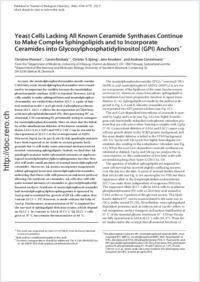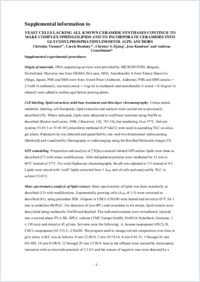Yeast cells lacking all known ceramide synthases continue to make complex sphingolipids and to incorporate ceramides into glycosylphosphatidylinositol (GPI)
- Vionnet, Christine Department of Medicine, University of Fribourg, Switzerland
- Roubaty, Carole Department of Medicine, University of Fribourg, Switzerland
- Ejsing, Christer S. Department of Biochemistry and Molecular Biology, University of Southern Denmark, Odense M, Denmark
- Knudsen, Jens Department of Biochemistry and Molecular Biology, University of Southern Denmark, Odense M, Denmark
- Conzelmann, Andreas Department of Medicine, University of Fribourg, Switzerland
-
20.12.2010
Published in:
- Journal of Biological Chemistry. - 2011, vol. 286, p. 6769-6779
English
In yeast, the inositolphosphorylceramides mostly contain C26:0 fatty acids. Inositolphosphorylceramides were considered to be important for viability because the inositolphosphorylceramide synthase AUR1 is essential. However, lcb1Δ cells, unable to make sphingoid bases and inositolphosphorylceramides, are viable if they harbor SLC1-1, a gain of function mutation in the 1-acyl-glycerol-3-phosphate acyltransferase SLC1. SLC1-1 allows the incorporation of C26:0 fatty acids into phosphatidylinositol (PI), thus generating PI″, an abnormal, C26-containing PI, presumably acting as surrogate for inositolphosphorylceramide. Here we show that the lethality of the simultaneous deletion of the known ceramide synthases LAG1/LAC1/LIP1 and YPC1/YDC1 can be rescued by the expression of SLC1-1 or the overexpression of AUR1. Moreover, lag1Δ lac1Δ ypc1Δ ydc1Δ (4Δ) quadruple mutants have been reported to be viable in certain genetic backgrounds but to still make some abnormal uncharacterized inositol-containing sphingolipids. Indeed, we find that 4Δ quadruple mutants make substantial amounts of unphysiological inositolphosphorylphytosphingosines but that they also still make small amounts of normal inositolphosphorylceramides. Moreover, 4Δ strains incorporate exogenously added sphingoid bases into inositolphosphorylceramides, indicating that these cells still possess an unknown pathway allowing the synthesis of ceramides. 4Δ cells also still add quite normal amounts of ceramides to glycosylphosphatidylinositol anchors. Synthesis of inositolphosphorylceramides and inositolphosphorylphytosphingosines is operated by Aur1p and is essential for growth of all 4Δ cells unless they contain SLC1-1. PI″, however, is made without the help of Aur1p. Furthermore, mannosylation of PI″ is required for the survival of sphingolipid-deficient strains, which depend on SLC1-1. In contrast to lcb1Δ SLC1-1, 4Δ SLC1-1 cells grow at 37 °C but remain thermosensitive at 44 °C.
- Faculty
- Faculté des sciences et de médecine
- Department
- Département de Biologie
- Language
-
- English
- Classification
- Biological sciences
- License
-
License undefined
- Identifiers
-
- RERO DOC 22300
- DOI 10.1074/jbc.M110.176875
- Persistent URL
- https://folia.unifr.ch/unifr/documents/301796
Other files
Statistics
Document views: 133
File downloads:
- pdf: 148
- Supplementary material: 99
- Supplementary material: 61


